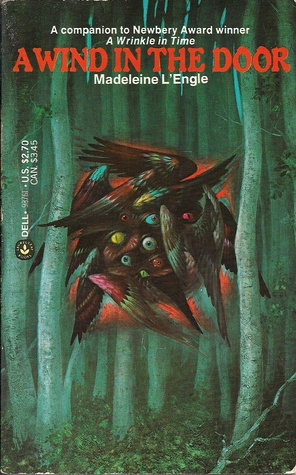I was inspired to read this book when my friend Abazaba expressed interest in re-reading the full 'Wrinkle in Time' series by Madeline Le'Engel. We had both read the first book when we were young, and were curious about the series following. I found both the first book and 'A Wind in The Door,' the second book, at Beers Books, our local used bookstore. At one dollar apiece, I could not pass them up. So I gave my friend the first while I read this one.
In brief synopsis, the Wrinkle In Time series follows young teenager Meg Murry, her little brother Charles Wallace and the rest of her family as they go through a series of adventures with magical beings. The stories always begin at their home in the north eastern United States, but span across the length and breadth of the universe. The first book focuses on folding space to cross great distances, and A Wind in the Door focuses on the unification of all creatures great and small, from the sub-microscopic to the galactic.
This book contains some really cool science fiction ideas. Le'Engel discusses concepts of scale in a really intriguing way. When talking about scale in terms of Astronomy and Chemistry, the sizes involved are beyond basic human comprehension. We have to think long and hard to really understand that we are just a speck of dust in a sunbeam.
Le'Engel tries to connect the tiniest of the tiny - a cell within a cell within a cell, with the largest of the large: A solar system within a galaxy within a universe. She pulls this off masterfully, through a bit of metaphysics and storytelling that tickles the mind and the soul. The notion that a human can be a universe to a mitochondrion, which is a solar system for Farandolae is fantastic, and she even tries to work together the idea of communication between these massively different bodies. She uses metaphysical 'kything' to bridge this gap, which is akin to telepathy, and reminds me a bit of 'Groking' (Stranger in a Strange land, Heinlein).
As a reader, I am already prepared to accept these concepts and imagine them, so I'm not sure of how good a job Le'Engle does of describing them to a layperson. In fact, there are portions of the book that I think are pretty well ham-fisted. I suppose this is due in part to this being a children's book, where things are best presented in a simple way, and in short-run. But it's not the science fiction or the metaphysics that is troubling to me, it's the storytelling.
There are unbelievable and frightening characters, whom the children of the story are compelled to just 'trust' instantly because of some sort of spiritual energy coming from them. This is a problematic issue for me. On the one hand, I love the innocence of it, the cleverness of the character design, and the guts to make a sympathetic character have a frightening appearance. But on the other hand, as a reader, I do not immediately trust the characters, and I'm essentially forced to do so because the narrator insists on it. I don't really like that. This is what I mean by ham fisted. Perhaps with a bit more time to flesh the world out, I may have synced up with the characters.
I think it's awesome that Le'Engel was inspired by Mitochondria. And I do find comfort in her unified theory of love. The respectful synthesis of science and spirituality is a lovely thing. I think I would enjoy these concepts adapted to an older audience, with more elegant storytelling. I recommend a Wind In the Door to anyone who likes science fiction. I think it is the best in a very original series.
-D


No comments:
Post a Comment